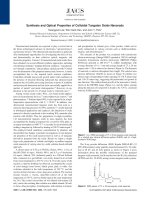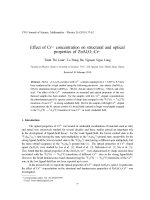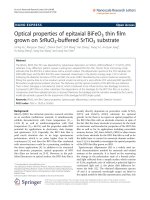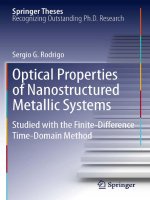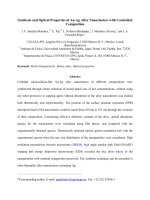Phonon characterization, structural and optical properties of Type-II CdSe/CdTe core/shell and Type-II/type-I CdSe/CdTe/ZnS core/shell/shell quantum dots
Bạn đang xem bản rút gọn của tài liệu. Xem và tải ngay bản đầy đủ của tài liệu tại đây (1.25 MB, 11 trang )
VNU Journal of Science: Mathematics – Physics, Vol. 36, No. 3 (2020) 47-57
Original Article
Phonon Characterization, Structural and Optical Properties
of Type-II CdSe/CdTe core/shell and Type-II/type-I
CdSe/CdTe/ZnS core/shell/shell Quantum Dots
Nguyen Xuan Ca*, Nguyen Thi Hien
Faculty of Physics, Thai Nguyen University of Sciences, Tan Thinh, Thai Nguyen, Viet Nam
Received 09 January 2020
Revised 17 February 2020; Accepted 05 April 2020
Abstract: The CdSe, type-II CdSe/CdTe core/shell and type-II/type-I CdSe/CdTe/ZnS
core/shell/shell quantum dots (QDs) were successfully synthesized in a noncoordinating solvent.
The phonon characterizations, optical properties and structures of the synthesized QDs were
characterized by Raman scattering (RS) spectra, photoluminescence (PL) spectroscopy, PL-decay
lifetime, absorption spectroscopy (Abs), and X-ray diffraction (XRD). The growth of QDs was
monitored by using RS, which demonstrated the formation of correct of the core/shell and
core/shell/shell structures. Observation results from XRD reveal that all QDs crystallize in the
cubic phase with zinc-blende structure. The typical characteristics of spatially indirect
recombination for type-II QDs were observed through Abs and PL spectroscopy. The ZnS shell
significantly enhanced the PL quantum yeild (QY), the optical durability, the chemical stability
and separating CdSe/CdTe QDs from the surroundings. The effect of excitation power on the PL
properties of the CdSe core, CdSe/CdTe and CdSe/CdTe/ZnS QDs has been investigated.
Keywords: Quantum dot, type-II/type-I, optical properties, photoluminescence.
1. Introduction
Colloidal semiconductors quantum dots (QDs) have been widely proposed to be used in
applications such as light-emitting devices, lasers, photovoltaic and biomedical fluorescent labels
because of the many desirable properties [1, 2]. They have many advantages compared to organic
fluorescence such as tunable emission wavelength, multiplexing capabilities, high-photoluminescence
* Corresponding author.
Email address:
https//doi.org/ 10.25073/2588-1124/vnumap.4452
47
48
N.X. Ca, N.T. Hien / VNU Journal of Science: Mathematics – Physics, Vol. 36, No. 3 (2020) 47-57
(PL) quantum yield (QY), and high photoresistance [2-4]. Recently, many studies have focused on
the synthesis of the type-II semiconductor QDs. They were constructed from the two materials for
which both the conduction and valence bands of one component lie lower in energy than the
corresponding bands of the other component [5, 6]. Type-II QDs have an effective bandgap energy
that is smaller than that of either the constituent core or shell. For example, CdTe/CdSe or CdSe/CdTe
QDs can emit infrared radiation that is even beyond the bulk band gaps of either CdSe or CdTe, so
they can be conveniently used for in vivo imaging [7]. Furthermore, the spatial charge separations of
electrons/holes between the core/shell and extended absorptions of type-II QDs can be advantageous
for photovoltaic applications and lasers [8]. Although there are many potential applications but the
optical properties of type-II QDs have not been clearly understood due to the difficulties in making
high quality QDs [9].
Since Bawendi's first research in 2003 [10], for the first time, type-II CdTe/CdSe core/shell QDs
were successfully prepared by using the colloidal chemical method. Afterwards, a series of type-II
core/shell QDs such as CdS/ZnSe [3, 6], CdTe/CdSe [11], CdTe/ZnSe [12], ZnTe/ZnSe [13], and
ZnTe/CdSe [14] has been fabricated in recent years. For the above QDs, the type-II CdTe/CdSe
core/shell QDs were fabricated more than other QDs, because it can be separated completely electrons
and holes between the core and shell layers. The type-II CdTe/CdSe core/shell QDs have emission
wavelengths in the visible region and can change in a very wide range when changing core size and
shell thickness. The bandgap energy of CdTe/CdSe and CdSe/CdTe QDs are the same, but the
physical nature and their applications are different. For the CdTe/CdSe QDs, electrons locate in the
shell and holes locate in the core, while the CdSe/CdTe QDs are opposite. Electrons locate in the core
of the CdSe/CdTe QDs, which have many potential applications in solar cells and give higher emission
efficiency, because electrons are not arrested by traps on the surface of the QDs. Compared with the
CdTe/CdSe QDs, the CdSe/CdTe QDs are less studied and fabricated due to the shell containing Te
compound. A problem associated with a practical use of CdSe/CdTe QDs is known that the CdTe shell
is easily oxidized, which results in reduced chemical stability. Oxidation also reduces quantum yeild
(QY) and may require incorporation of additional protection layers that isolate the Te-based material
from the environment for improved PL QY [7, 11].
In this work, we investigate the crystal structure and optical properties of type-II/type-I
CdSe/CdTe/ZnS core/shell/shell QDs and comparison with the traditional type-II CdSe/CdTe
core/shell QDs. The type-II characteristic of CdSe/CdTe core/shell QDs were clarified by UV–vis
absorption and PL spectra. The formations of the zincblende and core/shell/shell structure were
monitored by using Raman scattering (RS) and an X-ray diffractometer. The additional ZnS shell, with
large bandgap energy, efficiently confines both electrons and holes in the CdSe/CdTe structure and
significantly enhances the indirect radiative recombination at the CdSe core and inner CdTe shell
interface. Furthermore, the ZnS shell also helps to enhance PL QY, the optical durability, the chemical
stability and separating CdSe/CdTe QDs from the surroundings.
2. Experimental Details
Chemicals
Cadmium oxide (CdO, 99.99%, powder), Zinc oxide (ZnO,99.99%), 1-octadecene (ODE, 90%),
Oleic acid (OA, 90%), Tellurium (Te, 99.99%, powder ), Selenium (Se, 99.99%, powder), Toluene
(99.8%), Isopropanol (99.7%) and Tri-n-octylphosphine (TOP, 97%) were purchased from SigmaAldrich.
N.X. Ca, N.T. Hien / VNU Journal of Science: Mathematics – Physics, Vol. xx, No. x (2020) 47-57
49
Synthesis of CdSe quantum dots
A mixture of CdO (128 mg), OA (3 ml), and ODE (20 ml) in a flask was heated to 260 oC and
stirring. A solution of Se (79 mg) and TOP (1ml) in ODE (5ml) was swiftly injected into above hot
solution for the growth of CdSe QDs. The fabricated CdSe QDs were purified by centrifuging to
remove extra unreacted Cd2+ and Se2- ions. The purified CdSe QDs were dissolved in toluene and ODE
for using to cover CdTe shell. Note that all of the synthesis processes were performed in nitrogen
ambience to avoid oxidation.
Overcoating with CdTe shell
The Te2- precursor was prepared by mixing 128 mg of Te powder, 1mL TOP and 4 ml of ODE
in a flask, then heated to 100 oC. The Cd2+ (prepared as above) and Te2- precursors solution were
swiftly injected into the solution containing CdSe QDs at 250 °C. The growth was carried out for 20
min to grow the CdTe shell. The fabricated CdSe/CdTe QDs were purified and dissolved in toluene
and ODE to cover ZnS second shell.
Overcoating with ZnS shell
A mixture of ZnO (81mg), OA (3 ml), and ODE (20 ml) in a flask was heated to 260 oC. S2- precursor
was prepared by mixing 32 mg of S powder and 4 ml of ODE in a flask, then heated to 120 oC. Zn2+
and S2- precursors solution were swiftly injected into the solution containing CdSe/CdTe QDs at 220
°C and annealing for 20 min to grow the ZnS shell. The fabricated CdSe/CdTe/ZnS QDs were purified
and dissolved in toluene for studying the structural and optical properties afterwards.
Characterizations
To study the optical properties, Ultraviolet–visible (UV–vis) absorption spectra were analyzed
by using a Jasco V-770 spectrometer (Varian). Raman (RS) and PL spectra were performed on a
LABRAM-HR800 spectrometer (Horriba, Jobin Yvon). In our work, excitation power could be
changed in the ranges of 0.01–10 mW (using a filter power density). PL decay curves were recorded
by a home-built time-resolved PL system with an excitation wavelength of 405 nm. The crystal
structure of the fabricated samples was checked using an X-ray diffractometer (Siemens, D5005)
equipped with a Cu-Kα radiation source. All investigations were carried out at room temperature.
3. Results and Discussion
Firstly, we use an RS spectra to monitor the formation of CdTe and ZnS shells on the CdSe cores.
Figure 1 shows the RS spectra of CdSe core, CdSe/CdTe core/shell and CdSe/CdTe/ZnS
core/shell/shell QDs were excited by wavelength of 488 nm. For the CdSe core, there are vibration
modes peaked at ∼206 and ∼ 412 cm-1, which are associated with the longitudinal optical (1LOCdSe
and 2LOCdSe) phonons of CdSe QDs [2, 11]. The 1LOCdSe position of bulk CdSe locates at about 213
cm-1 [11]. The redshift of this mode is ascribed to phonon confinement effects due to the size of CdSe
QDs. For CdSe/CdTe core/shell QDs, besides having two phonon modes of CdSe core, we can see
third mode at ∼ 157 cm-1. It is well known that the phonons vibration at ∼ 163 cm-1 is belong to the
longitudinal optical phonon of CdTe, which marked as 1LOCdTe [15]. The appearance of the phonon
mode at ∼ 157 cm-1 evidence that our CdSe/CdTe QDs are well formed in the core/shell structure. The
RS spectra of CdSe/CdTe/ZnS QDs shows that, besides 1LOCdSe, 2LOCdSe and 1LOCdTe peaks, there is
50
N.X. Ca, N.T. Hien / VNU Journal of Science: Mathematics – Physics, Vol. 36, No. 3 (2020) 47-57
an additional mode peaked at ∼350 cm-1, which is ascribed to the 1LOZnS phonon mode of the ZnS
shell. In particular, with coating ZnS shell layers, the phonon modes 1LOCdSe and 1LOCdTe of
CdSe/CdTe/ZnS QDs are shifted about 3 cm-1 towards higher wavenumbers, which is ascribed to the
lattice strain. The observed results of the phonon modes 1LOCdTe and 1LOZnS confirm the formation of
the core/shell/shell structure in CdSe/CdTe/ZnS QDs.
Figure 1. RS spectrum of CdSe, CdSe/CdTe, and CdSe/CdTe/ZnS.
Figure 2. XRD patterns of CdSe, CdSe/CdTe, and CdSe/CdTe/ZnS QDs.
N.X. Ca, N.T. Hien / VNU Journal of Science: Mathematics – Physics, Vol. xx, No. x (2020) 47-57
51
XRD pattern in Figure 2 reveals the crystal structures of CdSe, CdSe/CdTe core/shell, and
CdSe/CdTe/ZnS core/shell/shell QDs. The XRD patterns of all samples match with the zinc blende
structure and no indication of the hexagonal phase formation, all the peaks match well with the
standard Bragg reflections for the cubic structure. The diffraction peaks show broadening phenomena
because of the QDs’ small sizes. According to Scherrer’s formula, crystallite size D = Kλ/(Bcosθ) [16],
where K is the Scherrer constant, λ is the wavelength (1.5406 A˚ for Cu-Kα radiation), B is the FWHM
of the XRD peaks, and θ is the peak position. From the line width analysis of the (111) reflection peak
using the Scherrer equation, the average diameter of CdSe QDs is estimated about 5.4 nm, which is in
agreement with the result has obtained from the equation of Yu. After the growth of the CdTe shell,
the XRD peaks of CdSe/CdTe QDs shift to smaller angles because the CdTe lattice constant (0.648 Å)
is bigger than that of cubic CdSe (0.608 Å) [11, 15]. After the further growth of the ZnS shell, the
XRD peaks strongly shift to larger angles because the ZnS lattice constant (0.541 Å) is much smaller
than that of CdTe. The sustentive zincblende structure throughout the growth processes of CdTe and
ZnS shells are likely due to the surfactant system used. The QDs such as CdTe, CdSe, and CdS
synthesized in OA usually have zincblende structure because the ligand OA has a stabilizing effect on
this phase [17].
Figure 3. UV-vis absorption and PL spectra of CdSe, CdSe/CdTe, and CdSe/CdTe/ZnS QDs.
Figure 3 displays the absorption (Abs) and PL spectra of CdSe core, CdSe/CdTe core/shell and
CdSe/CdTe/ZnS core/shell/shell QDs. For the Abs spectra of CdSe core QDs, one can see clearly the
first excitonic absorption peaks at wavelength about 560 nm. The energy of this absorption peak
corresponding to the lowest energy transition of 1S3/2(h)-1S(e), which can be used to estimate the
diameter of the QDs according to Yu's empirical equation [18]. Using the equation of Yu: D =(1.6122
10-9)4 - (2.6575 10-6)3 + (1.624210-3)2 - (0.4277) + 41.57, with is first excitonic absorption
52
N.X. Ca, N.T. Hien / VNU Journal of Science: Mathematics – Physics, Vol. 36, No. 3 (2020) 47-57
peak, the size (D) of CdSe core QDs is determined ~5 nm. The PL spectra of CdSe QDs shows a peak
at ~ 575 nm corresponding to the recombination of the electron in the conduction band and the holes in
the valence band, known as excitonic emission. The broadened peak at ~ 714 nm with the lower
intensity is assigned to the surface state of QDs [19]. The PL QY of CdSe core QDs is determined of
42.6 %. After the growth of the CdTe shell, Abs spectra of CdSe/CdTe core/shell QDs appears a long
absorption tail at long wavelength (from 620 to 700 nm). The long tail and the smeared Abs peaks are
considered as a signature of the spatial indirect absorption of the type-II QDs [15, 20]. As the CdTe
shell grows on CdSe core, the PL peak red shifts from 575 nm for the CdSe core to 670 nm for type-II
CdSe/CdTe core/shell QDs. This redshift is typical characteristics for type-II QDs due to the spatially
indirect recombination of the charge carriers at the type-II heterojunction. The similar results were
observed previously in studies of the type-I to the type-II transition in CdTe/CdSe [11] or CdS/ZnSe
[3, 6] QDs. The PL QY decrease from 42.6 % for CdSe core to 33.4 % for CdSe/CdTe core/shell QDs.
The growth of the CdTe shell leads to the decrease of the PL QY due to the significant reduction of the
electron-hole function overlap in type-II QDs. Low PL QY has been seen as an intrinsic limitation of
type-II QDs, because the slower radiative recombination of indirect excitons should create the
favorable conditions for the dominance of nonradiative recombination [21].
Figure 4. PL spectrum of CdSe, CdSe/CdTe, and CdSe/CdTe/ZnS QDs according to storage time.
When the additional ZnS shell grows on CdSe/CdTe core/shell QDs, the PL peak of
CdSe/CdTe/ZnS core/shell/shell slightly redshifts about 7 nm compare to that of CdSe/CdTe core/shell
QDs. This was expected because ZnS (3.6 eV) has a very wide bandgap in comparison to CdTe (1.4
eV) that forms the type-I structure with the ZnS shell [2, 7]. As expected, the PL QY of the
CdSe/CdTe core/shell QDs was significantly enhanced (up to 48.7 % ) upon the growth of the ZnS
shell. The research result with CdS/ZnSe QDs also shown that the PL QY of these QDs were improved
from about 30% to 60% after the growth of thick ZnS shell [22]. ZnS shell was grown to improve the
QY and PL stability of CdSe/CdTe core/shell QDs because the large bandgap semiconductor ZnS
N.X. Ca, N.T. Hien / VNU Journal of Science: Mathematics – Physics, Vol. xx, No. x (2020) 47-57
53
confined the photoexcited excitonics in the CdSe/CdTe core/shell QDs, reduced oxidized, chemical
stability, and nonradiative recombinations through the surface defects of CdTe shell was eliminated [7,
22]. It can be seen in Figure 4 that the CdSe/CdTe/ZnS QDs still emitted well after one year of storage
under normal conditions, while the CdSe and CdSe/CdTe QDs were almost no longer emitted.
In order to further understand the physical process underlying the spectra feature of the type-I and
type-II QDs emission, we measured the decay curves of the excitonic emission of three samples, which
are shown in Figure 5. The PL decay can be fitted to a triexponential function: I (t )
3
Ae
i 1
i
t
i
[6,
15], where Ai and τi are the magnitude and lifetime of the ith component, respectively. The τi values are
strongly dependent on various crystal sizes and morphologies. Average lifetime 〈τ〉 can be determined
from the Ai and τi values as: t
3
3
A / A
i 1
2
i i
i 1
i i
[6, 15]. The measured 〈τ〉 are 12.7 ns for the CdSe
core, 56.2 ns for the CdSe/CdTe core/shell, and 47.4 ns for the CdSe/CdTe/ZnS core/shell/shell. The
appreciable increase in the excitonic lifetime observed for type-II CdSe/CdTe QDs compare to the
CdSe cores is primarily due to the spatial separation of the electron and hole, and the increase of the
nonradiative decay rates, since it is accompanied by a significant decrease of the PL QY ( from 42.6 %
down 33.4 %). A further growth of the ZnS shell leads to decreasing the exciton lifetime suitable for
increasing the PL QY of CdSe/CdTe/ZnS QDs ( from 33.4 % to 48.7 %) .
Figure 5. Time-resolved PL decays of CdSe, CdSe/CdTe, and CdSe/CdTe/ZnS QDs.
In an attempt to investigate the emission dynamics, we changed excitation power from 0.01 to 10
mW, and studied their influences on the PL properties of CdSe, CdSe/CdTe and CdSe/CdTe/ZnS QDs.
The PL spectrum shown in Figure 6(a–c) show that though the spectral shape remains unchanged but
the spectral parameters vary remarkably. The dependence of integrated emission intensity on the
54
N.X. Ca, N.T. Hien / VNU Journal of Science: Mathematics – Physics, Vol. 36, No. 3 (2020) 47-57
excitation power of samples is observed in the Figure 7a. The integrated emission intensity versus the
excitation power obeys a law of I ∝ Pk, where k is a power factor reflecting different natures of the
emissions. For CdSe QDs, k=0.97 (∼1), which is expected for the transitions associated with free
excitonics [23]. This transition processes are related to the direct recombination of electrons and holes
confined in CdSe core. For CdSe/CdTe and CdSe/CdTe/ZnS QDs, k takes the values of 1.36 and 1.42,
respectively. The values of k >1 is due to different natures of the emissions, they could be for bound
excitionics, donor-acceptor pairs [24], and the bounding of excitonics to isoelectronic defects [25].
These k values associated to the emission of the type-II QDs, which related to the indirect
recombination of the spatially separate electrons and holes between the core and the shell.
Figure 6. PL spectrum of CdSe, CdSe/CdTe, and CdSe/CdTe/ZnS QDs when excitation power increases from
0.01 - 10 mW.
The results in Figure 6 show the emission peaks of CdSe QDs were unchanged, while that of
CdSe/CdTe and CdSe/CdTe/ZnS QDs were shifted towards high energies as increasing the excitation
power. It is well known that the type-II QDs show a characteristic of the blueshift of PL spectra with
increasing excitation power, while the blueshift is not observed in type-I QDs [6, 15]. The blueshift
phenomena of PL in type-II QDs has been explained by several mechanisms, such as the capacitive
charging (CC) [26], state filling (SF) [27], and band bending (BB) [15, 28]. The CC effect is caused by
the repulsion interaction force between the same electric charge (electron-electron or hole - hole),
which is much larger than the attraction interaction force between electrons and holes. The result of
this effect is that the emission energy is proportional to the square root of the excitation power (
E ~ P1/ 2 ). The BB effect is a consequence of the bending of the energy region of type-II QDs. The
separation of carriers are generated by optical excitation into different spatial regions of type-II
core/shell QDs. When the excitation power is high, the carriers will intensively concentrate at the
interface to produce the internal electric field, and cause the bending of conduction and valence bands
of the semiconductor components. For BB effect, the emission energy is linearly proportional to the
cube root of the excitation power ( E ~ P1 / 3 ). Analyzed PL data are shown Figure 7b. For CdSe cores,
the dependence of the emission energy and the excitation power is constant. However, the situation
became different for the CdSe/CdTe core/shell and CdSe/CdTe/ZnS core/shell/shell samples. The PL
N.X. Ca, N.T. Hien / VNU Journal of Science: Mathematics – Physics, Vol. xx, No. x (2020) 47-57
55
spectrum of CdSe/CdTe and CdSe/CdTe/ZnS show a clear blueshift about 17 and 21 meV,
respectively, and its PL peak has is the linear relationship with the third root of excitation power. This
result proves that the BB effect is the cause for the blueshift of PL peaks as increasing excitation
power. The BB effect has also been observed with the CdTe/CdSe [15] and CdS/ZnSe [6], however
the blueshift energy is different depending on the sample nature. The BB effect of CdSe/CdTe/ZnS
QDs is more strongly than that of CdSe/CdTe QDs because the ZnS shell has good passivation of the
defects on surface of CdSe/CdTe QDs, which is suitable for the QY enhancement of CdSe/CdTe/ZnS
QDs.
Figure 7. (a) Dependence of integrated PL intensity on the excitation power.
(b) Dependence of PL peak energy on the cube root of excitation power.
4. Conclusion
The CdSe, type-II CdSe/CdTe core/shell and type-II/type-I CdSe/CdTe/ZnS core/shell/shell QDs
were synthesized in ODE solvent. The formation of the core/shell and core/shell/shell structures was
proved by using RS. XRD reveal that all samples crystallize in the cubic phase with zinc-blende
structure. The typical characteristics of spatially indirect recombination for type-II QDs were observed
through Abs and PL spectroscopy. The ZnS shell significantly enhanced the PL QY, the optical
durability, the chemical stability and separating CdSe/CdTe QDs from the surroundings. The effect of
excitation power on the PL properties of the CdSe core, CdSe/CdTe and CdSe/CdTe/ZnS QDs has
been investigated.
Acknowledgments
This research is funded by Vietnam National Foundation for Science and Technology Development
(NAFOSTED) under grant number 103.02-2017.350.
56
N.X. Ca, N.T. Hien / VNU Journal of Science: Mathematics – Physics, Vol. 36, No. 3 (2020) 47-57
References
[1] A. Nemchinov, M. Kirsanova, N.H. Kasakarage, M. Zamkov, Synthesis and Characterization of Type II
ZnSe/CdS Core/Shell Nanocrystals, J. Phys. Chem. C. 112 (2008) 9301–9307.
/>[2] W. Zhang, G. Chen, J. Wang, B.C. Ye, X. Zhong, Design and Synthesis of Highly Luminescent Near-InfraredEmitting Water-Soluble CdTe/CdSe/ZnS Core/Shell/Shell Quantum Dots, Inorg. Chem. 48 (2009) 9723–9731.
/>[3] H.T. Van, N.X. Ca, N.T. Hien, P.M. Tan, T.L. Phan, L.D. Thanh, P.V. Do, N.Q. Bau, V.T.K. Lien, Tunable dual
emission in type-I/type-II CdSe/CdS/ZnSe nanocrystals, J. Alloy. Compd. 791 (2019) 144-151.
/>[4] C. Zhang, S. Liu, X. Liu, F. Deng, Y. Xiong, F.C. Tsai, Incorporation of Mn2+ into CdSe quantum dots by
chemical bath co-deposition method for photovoltaic enhancement of quantum dot-sensitized solar cells, R. Soc.
Open. Sci. 5 (2018) 171712. />[5] N.H. Kasakarage, P.Z. Khoury, A.N. Tarnovsky, M. Kirsanova, I. Nemitz, A. Nemchinov, M. Zamkov, Ultrafast
Carrier Dynamics in Type II ZnSe/CdS/ZnSe Nanobarbells, ACS Nano. 4 (2010) 1837–1844.
/>[6] N.X. Ca, V.T.K. Lien, P.M. Tan, N.T. Hien, V.X. Hoa, T.T.K. Chi, N.X. Truong, V.T.K. Oanh, N.T.M. Thuy,
Tunable photoluminescent Cu-doped CdS/ZnSe type-II core/shell quantum dots, J. Lumin. 215 (2019) 116627.
/>[7] H.Q. Huang, J.L. Liu, B.F. Han, C.C. Mi, S.K. Xu, Cell labeling and cytotoxicity of aqueously synthesized
CdTe/CdS/ZnS core–shell–shell quantum dots by a water bath-hydrothermal method, J. Lumin. 132 (2012) 1003.
/>[8] J. Bang, J. Park, J.H. Lee, N. Won, J. Nam, J. Lim, B.Y. Chang, H.J. Lee, B. Chon, J. Shin, J.B. Park, J.H. Choi,
K. Cho, S.M. Park, T. Joo, S. Kim, ZnTe/ZnSe (Core/Shell) Type-II Quantum Dots: Their Optical and
Photovoltaic Properties, Chem. Mater. 22 (2010) 233–240. />[9] C.H. Wang, T.T. Chen, K.W. Tan, Y.F. Chen, Photoluminescence properties of CdTe/CdSe core-shell type-II
quantum dots, J. Appl. Phys. 99 (2006) 123521. />[10] S. Kim, B. Fisher, H.J. Eisler, M.G. Bawendi, Type-II Quantum Dots: CdTe/CdSe(Core/Shell) and
CdSe/ZnTe(Core/Shell) Heterostructures, J. Am. Chem. Soc. 125 (2003) 11466.
/>[11] G.R. Bhand, N.B. Chaure, Synthesis of CdTe, CdSe and CdTe/CdSe core/shell QDs from wet chemical colloidal
method, Mater. Sci. Semicond. Process. 68 (2017) 279-287. />[12] N.H. Kasakarage, N.P. Gurusinghe, M. Zamkov, Blue-Shifted Emission in CdTe/ZnSe Heterostructured
Nanocrystals, J. Phys. Chem. C. 113 (2009) 4362-4368. />[13] S.M. Fairclough, E.J. Tyrrell, D.M. Graham, P.J.B. Lunt, S.J.O. Hardman, A. Pietzsch, F. Hennies, J. Moghal, W.
R. Flavell, A.A.R. Watt, J.M. Smith, Growth and Characterization of Strained and Alloyed Type-II ZnTe/ZnSe
Core–Shell Nanocrystals, J. Phys. Chem. C. 116 (2012) 26898-26907. />[14] Z. Jiang, D.F. Kelley, S. Krastanov, Stranski–Krastanov Shell Growth in ZnTe/CdSe Core/Shell Nanocrystals, J.
Phys. Chem. C. 117 (2013) 6826-6834. />[15] N.X. Ca, N.T. Hien, N.T. Luyen, V.T.K. Lien, L.D. Thanh, P.V. Do, N.Q. Bau, T.T. Pham, Photoluminescence
properties of CdTe/CdTeSe/CdSe core/alloyed/shell type-II quantum dots, J. Alloy. Compd. 787 (2019) 823-830.
/>[16] N.X. Ca, H.T. Van, P.V. Do, L.D. Thanh, P.M. Tan, N.X. Truong, V.T.K. Oanh, N.T. Binh, N.T. Hien, Influence
of precursor ratio and dopant concentration on the structure and optical properties of Cu-doped ZnCdSe-alloyed
quantum dots, RSC Adv. 10 (2020) 25618. />[17] P.T. Tho, N.D. Vinh, H.T. Van, P.M. Tan, V.X. Hoa, N.T. Kien, N.T. Hien, N.T.K. Van, N.X. Ca, Effects of
chemical affinity and injection speed of Se and Te precursors on the development kinetic and optical properties of
ternary alloyed
CdTe1-xSex
nanocrystals,
J.
Phys.
Chem.
Solid. 139
(2020)
109332.
/>
N.X. Ca, N.T. Hien / VNU Journal of Science: Mathematics – Physics, Vol. xx, No. x (2020) 47-57
57
[18] W.W. Yu, L. Qu, W. Guo, X. Peng, Experimental determination of the extinction coefficient of CdTe, CdSe, and
CdS nanocrystals, Chem. Mater. 15 (2003) 2854-2860. />[19] H.T. Van, N.D. Vinh, P.M. Tan, U.T.D. Thuy, N.X. Ca, N.T. Hien, Synthesis and optical properties of tunable
dual emission copper doped CdTe1-xSex alloy nanocrystals, Optic. Mater. 97 (2019) 109392.
/>[20] B. Blackman, D.M. Battaglia, T.D. Mishima, M.B. Johnson, X. Peng, Control of the Morphology of Complex
Semiconductor Nanocrystals with a Type II Heterojunction, Dots vs Peanuts, by Thermal Cycling, Chem. Mater.
19 (2007) 3815–3821. />[21] P.T.K. Chin, C.M. Donega, S.S.V. Bavel, S.C.J. Meskers, N.A.J.M. Sommerdijk, R.A.J. Janssen, Highly
Luminescent CdTe/CdSe Colloidal Heteronanocrystals with Temperature-Dependent Emission Color, J. Am.
Chem. Soc. 129 (2007) 14880-14886. />[22] J.Z. Niu, H. Shen, C. Zhou, W. Xu, X. Li, H. Wang, S. Lou, Z. Du, L.S. Li, Controlled synthesis of high quality
type-II/type-I CdS/ZnSe/ZnS core/shell1/shell2 nanocrystals, Dalton Trans. 39 (2010) 3308–3314.
/>[23] V.I. Klimov, S.A. Ivanov, J. Nanda, M. Achermann, I. Bezel, J.A. McGuire, A. Piryatinski, Single-exciton optical
gain in semiconductor nanocrystals, Nat. Commun. 24 (2007) 441-447. />[24] F. Luckert, M.V. Yakushev, C. Faugeras, A.V. Karotki, A.V. Mudryi, R.W. Martin, Excitation power and
temperature dependence of excitons in CuInSe2, J. Appl. Phys. 111 (2012) 093507.
/>[25] J. Weber, W. Schmid, R. Sauer, Localized exciton bound to an isoelectronic trap in silicon, Phys. Rev. B. 2
(1980) 2401. />[26] P.D. Hodgson, R.J. Young, M.A. Kamarudin, P.J. Carrington, A. Krier, Q.D. Zhuang, E.P. Smakman, P.M.
Koenraad, M. Hayne, Blueshifts of the emission energy in type-II quantum dot and quantum ring nanostructures,
J. Appl. Phys. 114 (2013) 073519. />[27] K. Suzuki, R.A. Hogg, Y. Arakawa, Structural and optical properties of type II GaSb/GaAs self-assembled
quantum dots grown by molecular beam epitaxy, J. Appl. Phys. 85 (1999) 8349.
/>[28] H.T. Van, N.D. Vinh, N.X. Ca, N.T. Hien, N.T. Luyen, P.V. Do, N.V. Khien, Effects of ligand and chemical
affinity of S and Se precursors on the shape, structure and optical properties of ternary CdS 1-xSex alloy
nanocrystals, Mater. Lett. 264 (2020) 127387. />



